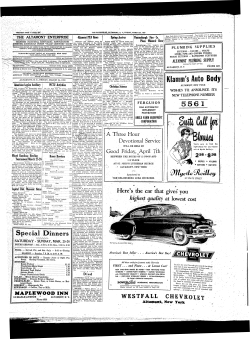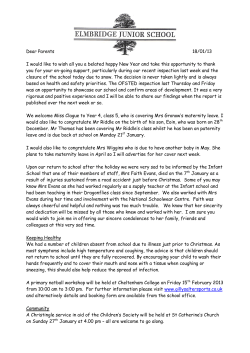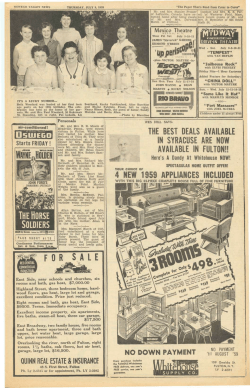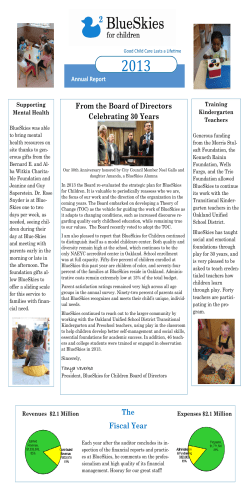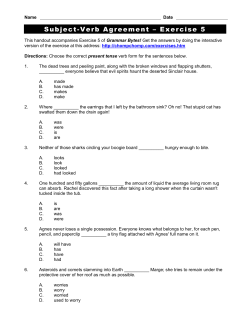
NEWS NOTEs Wallis Warfield in Warrenton, and Beyond AND
NEWS AND NOTEs from The Fauquier Historical Society Vol. 22, No.2 WARRENTON, VIRGINIA Spring & Summer 2000 Part II: Romance, Abdication and Exile Wallis Warfield in Warrenton, and Beyond By JOHN TOLER Newsletter Editor Upon her return from China in September 1925, Wallis resolved to end her marriage with Win Spencer. While staying with her cousin Corrine Mustin Murray at Wakefield Manor in Warren County, she began the legal work to obtain her divorce. Cousin Corrine introduced Wallis to Front Royal Attorney Aubrey "Kingfish" Weaver, a family friend who agreed to handle the divorce. It was determined that the most expedient grounds for the divorce would be Win's "desertion." In addition to one-year of residency in Virginia, Wallis would be required to produce a document from Win stating that he no longer wanted to live with her, and that he had in fact deserted her. Wallis contacted Win at Hampton Roads, and asked him to write a letter to that effect. She further requested that he backdate his statement to June 1924, to coincide with his assignment to China - although in fact the couple lived together there for several months before Win moved out. Under this scheme, the divorce could be granted as soon as June 24, 1927. Wallis went ahead with the plan, but surprisingly had a last-minute change of heart. When Win arrived at Weaver's office in Front Royal to go over the paperwork, she offered to reconcile. But Win insisted that they go through with the divorce. Then, the issue of Virginia residency had to be addressed. Wallis traveled to Warrenton on October 5, 1925,staying first at Oakwood, the home of Mr. and Mrs. Sterling Larrabee, old friends of Cousin Corrine. The Warren Green Hotel at the time of Wallis Warfield's stay. She returned to Washington briefly before beginning her stay in Warrenton. According to an article written for The Fauquier Democrat in 1950 by M. Louise Evans, 'The Old Timer," a family connection with Warrenton was established years before when her mother, Alice Montague, spent summers in the home of Mr. and Mrs. John James on Main Street. It was later the home of Dr. Frank Folk, and is now owned by Mr. and Mrs. Robert Rice. But unlike her mother, Wallis would not be vacationing in Warrenton. For the next year or so, her home would be Room 212 in the Warren Green Hotel, overlooking Hotel Street and the Fauquier National Bank. She would have to share a bathroom. In her autobiography, she describes her arrival in town: "So one hot October morning I took the early train ... the dusty, rattling train had left my flowered chiffon dress as dispirited as I was myself. I did not have the resolution to lift my bags. In this extremity, an affable Negro porter came up, introduced himself as 'Jake from the hotel,' and asked me to follow him."! She goes on to describe her hotel room as "fifteen feet by twelve, with faded flowered wallpaper, a high brass bed, battered night table, imitation mahogany bureau ... a classic example of what my mother used to call inferior decorating." "Wallis Spencer had no servants at the hotel," wrote Edwina H. Wilson in her biography, Her Name Was Wallis Warfield. "But Jake, the old colored porter, could not do enough for her. Jake used to wash her dog, "Sandy" ... which she had acquired by adoption. He had other owners, but as long as Wallis was in Warrenton, he remained with her." While living at the hotel, Wallis found herself most often in the company of traveling salesmen, or "drummers," (Continued on Page 2) Exile (Continued from Page 1) since the Warren Green was at the time chiefly a commercial hotel. She met an older man who lived at the hotel named Jack Mason who appeared to have some culture and had lived for many years in England. They became friends, often taking long walks around town. "On the whole, my first year at Warrenton was the most tranquil I have ever known," she wrote. "I simply rusticated, and when I wasn't rusticating, I vegetated with equal satisfaction."2 Years later, M. Louise Evans wrote, "Wallis Warfield Spencer loved Warrenton, and Warrenton loved Wallis, for a more personable girl never lived. She was universally popular with both sexes, and certainly 'the last word' in smartness of attire and neatness."3 As she did everywhere else, Wallis made friends and renewed acquaintances while in Warrenton. Her circle of friends included Phoebe Randolph, an old classmate from Arundell, who was married to Henry Poole, and Florence Campbell, a friend from Oldfields, now Mrs. Edward Russell. Also returning from Wallis' past were Lloyd Tabb, her first boyfriend from the old days at Burr/and, and remarkably, Dr. Miles Lewis Allen, the NEWS and NOTES Published Twice a Year by the FAUQUIER HISTORICAL SOCIElY, INC. A non-profit organization incorporated under the laws of the Commonwealth of Virginia. Dues and contributions are tax-deductible. c. 2000.Allrights reserved. Annual Dues Individual or Family Contributing Member Sustaining Member Business Membership Student Membership $10.00 15.00 (min.) 25.00 25.00 3.00 Officers President: Maxwell Harway Vice President: Janet Hofer Secretary: linda Anderson Treasurer: William Skinker JOHN T. TOLER Newsletter Editor Museum Director: Jackie Lee Honorary Members: Isabel S. Palmer and John K Gott Address Inquiries to: The Fauquier Historical Society P.O. Box 675 Warrenton, VA20188 Telephone: (540) 347-5525 HUGH ARMISTEAD SPILMAN 1892-1980 Hugh Spilman was a native and life-long resident of Warrenton. Many knew him through his longterm affiliation with the Fauquier National Bank and his 65-year membership in the Fauquier Club, but he is best remembered for his humor and congeniality. The perennial bachelor and man-about-town, Hugh was finally married in January 1954 to Wilmotine P. owens, widow of Dr. W Duncan Owens. But the union fasted only until November 1955, when Mrs. Spilman succumbed to cancer. physician who delivered her, who was now living in Winchester. Others she socialized with included Arthur and Jane Derby; Mr. and Mrs. Baldwin Spilman, who at the time owned Clovelly on the Springs Road; and Mr. and Mrs. Fred Hasrick, Mr. and Mrs. Robert Winmill and Mr. and Mrs. John Buchanan. Friends from the Middleburg area included Mr. and Mrs. Arthur White. Perhaps her most memorable friend was Hugh Spilman (1892-1980), whom she had dated years before, when Hugh was a student at the exclusive Gilman School in Baltimore and she was at Oldfields. During World War I, Spilman served in France with an ambulance company. In Wallis' autobiography, she wrote briefly of their relationship. "After a time, I ran into an old acquaintance, Hugh Spilman, who worked in the bank and whom I knew in Baltimore. He took me in tow and launched me in the social whirl of the local horsy set. He was also possessed of an old three-pedal rattling flivver. The two of us must have made quite an impression as we rolled up to the porticoed mansions for formal dinners."4 According to Higham, Spilman was "a blond and good-looking former footballer" who Wallis first met "in the dancing class where she had learned the two-step." "Spilman told her he was working as a teller, to learn the business, at the Fauquier National Bank. They became close in those drawn-out weeks of boredom. Wallis would drop by the bank (whichwas directly across from the hotel) and drink Coca-Colathrough straws from the bottle until the manager ordered Hugh back to his window. On Sundays (2) they played golf; they spent evenings at the golf club cafe', where they played poker until the small hours. Spilman remembered Wallis as a bad loser." View from Room 212 of the Warren Green, as it appears today. Those who knew Hugh Spilman were aware of his unrequited love for Wallis. As Higham explains, "Spilman asked her to marry him as soon as her divorce was over; she refused politely, pointing out that if she ever married again, it would only be for money. Spilman manfully settled for second best. He joined her at lawn parties and second-floor parlor dances and private social gatherings at the Warren Green. It was a harmless, pleasant romance."5 Warrenton insurance executive G. Wayne Eastham, who has worked on Culpeper Street for many years, recalls another local legend about the Warfield- (Continued on Page 3) Exile (Continued from Page 2) Spilman relationship: "After Wallis left Warrenton, she told her friends that she would have married Hugh if he knew how to read anything besides the Daily Racing Form." Wallis spiced-up her "rustic" life with frequent trips to Washington, D.C. and Baltimore. Occasionally, she would ride the train to New York, where she would stay with her old friend, Mary Kirk, and her husband, Jacques Raffray. In mid-summer of 1927, she was invited on pleasure trip to Europe with her aunt, Bessie Merryman. While there, she got word that Uncle Sol Warfield had died, necessitating a quick return home. She missed the funeral. By then, the period of establishing the residency required for her divorce was nearing fulfillment. On December 6, 1927, her divorce petition was submitted to Fauquier County Circuit Court, where it was heard by Judge George Latham Fletcher. "Among the dispositions by her mother and others was the letter Win Judge George Latham Fletcher was supposed to have sent from China, complete with American postage stamps, a detail the judge chose to overlook," wrote Higham. 'There is no question that this was a collusive divorce, since Wallis' statement that she had not seen Win in four years was contradicted by the evidence, and she had omitted any mention of China from her disposition, thereby perjuring herself."6 The divorce decree was granted on Dec. 10, 1927. Wallis would return to Warrenton once or twice in later years, but today, few people remain who remember much about Wallis Warfield Spencer's time at the Warren Green. Long-time Warrenton resident D. Harcourt Lees was just a child in the 1920s and never met her, but he recalls that Wallis affected different people in his family in different ways. "My aunt liked her, but my mother and another aunt didn't think much of her at all," he said recently. But many Warrenton residents have felt over the years that her stay here was at least an interesting footnote in local history. . Her divorce final, Wallis was free, but she hadn't made plans on what she would do next. With "nowhere else to go" and limited funds coming from a small trust set up by Uncle Sol, she turned to thoughts of becoming a fashion writer, or even going to work selling steel construction scaffolding for a friend's company in New York. Neither of these endeavors ever materialized, so Wallis continued to miss out on the one thing she had never experienced in her life - holding down ajob. Husband Number Two While still living at the Warren Green, Wallis took up with a married man, Ernest Aldrich Simpson, of New York and London. Simpson was the president of an international company that bought and sold ships, and had strong ties, through his parents and the business, to England. It was during a visit over Christmas, 1927 with the Raffrays that Wallis met Simpson and his wife, the former Dorothea Parsons Dechert, whom he had married in 1923. They had a fouryear-old daughter. Simpson's marriage mayor may not have been in trouble before the affair with Wallis began. The first Mrs. Simpson, frail and prematurely gray, was in a hospital recovering from an illness when she became aware of the affair, and soon filed for divorce. She remained very bitter toward Wallis the rest of her life, and was quoted as saying, "Wallis was very smart. She stole my husband while I was ill."7 Wallis left Warrenton for good, and she and Ernest were married on July 21, 1928 - barely seven months after Wallis' divorce was final. This second marriage would serve one important purpose: introducing Wallis Warfield to British high society. The new Mrs. Simpson soon joined her husband in London. By now a skilled (3) Ernest Aldrich Simpson social climber, she quickly worked her way up the ladder to the highest levels of British society. Wallis had more than a passing interest in Edward Albert Christian George Andrew Patrick David Windsor, the Prince of Wales, for years. She met him informally through a mutual society friend, and later, she was formally introduced to the Royal Family at her presentation to the Court on June 10, 1931. (Interestingly enough, among the other nine American women presented at court that day was another local person, Mrs. Charles O. Broy, of Sperryville, Va.B) A mutual attraction was quietly established there, and the Prince invited Ernest and Wallis Simpson into his inner circle. The illicit romance bloomed somewhat discretely at first, and included overnight trips to country homes and other intimate get-togethers. In the beginning, most of these activities included Ernest; but as time passed, most did not. Whether or not Ernest Simpson knew what was going on - or just didn't care - no longer matters. Apparently, he had other romantic interests of his own, as well. By late 1936, Wallis Simpson would charge her husband with adultery, based on the contents of a love letter alleged to have been sent to her by mistake, and the results of the findings of her private investigators. The evidence was presented to a British court. It is ironic that while they were separated - and probably, even beforethat Wallis was deeply involved in a (Continued on Page 4) Warfield Simpson as Queen, King Edward modified his demands, offering to consent to a "morganatic" marriage to her. Under this arrangement, Wallis would be married to the King and would live in England. She would be given the title of "Duchess" or some other royal title, but not Queen. She would not be included on the Civil List (in terms of personal income), and should she have children, they would not be entitled to any part of the royal inheritance nor would they ascend to the throne. Wallis was intrigued by this offer and probably would have gone along with it. But the opposition - which was growing daily - would not, and shortly afterward, the King withdrew the idea. A constitutional crisis loomed. By the first week of December 1936 Edward VIII decided that his only course of action was to abdicate the throne. Assisted by Winston Churchill, he wrote his abdication speech, which he delivered by radio broadcast on Dec. 10, Exile (Continued from Page 3) similarly adulterous relationship with the Prince of Wales. The divorce decree was issued by the judge on October 27, 1936, and was accompanied by much public interest and fanfare. Ernest Simpson did not even bother to show up. The name of the correspondent in the divorce case was withheld, but only months afterward, Ernest remarried. He chose as his third wife their old friend, Mary Kirk Ratfray. It was leaked that she had written the incriminating love letter. Could she be the one? Royal Romance Very few people outside of her closest circle of friends knew of the circumstances of Wallis' first two marriages, and considered her exhusbands to be at fault. As a result, most observers were sympathetic and intrigued by this interesting "woman with a past." During the depths of the Great Depression, the world watched with growing interest her fairy-tale romance with the Prince, next in line to become the King of England. And as this romance played out in the world media, there is no doubt that many local people recalled Wallis Warfield's days in Warrenton, less than a decade earlier. The world press closely followed the couple's comings-and-goings on yachts and in private train cars, and stays in Medieval castles across Europe. Following her divorce from Ernest, Wallis lived at Cumberland Terrace in Regent's Park, where she continued her affair with the Prince and gave parties for her friends and sycophants. Among those likely to be present at a soiree at her home were the usual British upper crust, but often Joachim von Ribbentrop, Adolph Hitler's special adviser for foreign affairs was there. In addition to detailed descriptions in the writings of Higham and Birmingham, this fact is presented most matter-offactly in the Wilson biography as wel1.9 With the death of King George V onJan. 19, 1936 and the accession ofthe Prince of Wales to the throne speculation ran rampant that Walli~ Simpson would soon become the next Queen of England. Months of turmoil would follow, as the King and the still-married Mrs. Simpson conducted their affair quite 1936. Wallis Warfield Simpson at her presentation to the Royal Court, 1931. openly. She was a frequent overnight guest at Fort Belvedere, the King's country home, and accompanied him on a tour of Europe on the yacht Nahlin and the Orient Express during the summer of 1936. The Royal Family was aghast, as were many Members of Parliament. In America, the mood was quite different, with many people excited about the possibility of Wallis Simpson becoming Queen, or at least marrying a king. There was not much interest in the constitutional angle here at home. The emphasis was focused solely on the romantic possibilities. The King had spent a great deal of time working in the background to make certain that the Simpson divorce was granted, but would not tell even his closest advisers what he ultimately was going to do. Futile Efforts In Buckingham Palace and in the backrooms of Parliament, much of the month of November 1936 was spent arguing the ramifications of a twicedivorced, foreign commoner becoming the Queen of England. When it became clear that many people - including his mother and brothers - would never accept Wallis (4) Wallis, who was staying in France with friends at that time, had tried in vain to convince him not to abdicate, and hoped until the last moment he would change his mind. She would have been happy to continue as his mistress, as long as he remained King. But a determined Edward VIII abdicated the throne after only 325 days to "marry the woman he loved." The crown passed to his brother, the Duke of York, who became King George VI. No longer burdened by his royal responsibilities, Edward immediately set forth to legalize the relationship that had cost him so much. Many decidedly un-romantic details had to be worked out as well: the (Continued on Page 5) Edward VIII, reading his abdication announcement over worldwide radio. i Exile (Continuedfrom Page 4) meaning of his new title, as "Duke of Windsor;" securing a regular income, and disposition of royal properties to he which he was once entitled. On May 11, 1937 - the day before his brother's coronation - he announced his engagement to Wallis Simpson. The wedding took place at the Chateau de Cande' on June 3, 1937. The Duke and Duchess of Windsor would remain married until parted by death; but in nearly all respects the "world class romance story" w~uld become a tarnished legacy of selfishness, excess and perfidy. Aftermath of Abdication In the years between the abdication and the outbreak of World War II the Duke and Duchess of Windsor presented an ongoing embarrassment for the Royal Family and for English citizens in general. With their excesses general insensitive behavior and outwardly Fascist/Nazi sympathies, they make the problems of the current "Royals" trivial by comparison. The most serious problem was the Windsors' relationship with Adolph Hitler and Italian dictator Benito Mussolini in the years leading up to World War II. The Duke, who spoke fluent High German, was in awe of the power and elitism of the self-proclaimed "master race." And there were other strange, deeprooted relationships that seem more like something out of a bad soap opera. Count Ciano, Wallis' old lover, was to married Mussolini's daughter. The chance meetings in the years before the war were understandably awkward. Former naval aviator Win Spencer emerged from the distant past as well. In 1936, he received a medal from Mussolini for helping his air minister, ltalo Balbo, set up the Italian air force. These odd relationships continued, even as Europe was falling to the Nazis. The Duke's attitude was clearly one of defiance: if his homeland would not accept his Queen, there just might be another way. On several occasions, the Duke met with Hitler and his agents to discuss "matters of mutual interest." According to Higham, one such meeting took place at Hitler's headquarters at Obersa1zburg, Germany, on October 22 1937. ' 'There was no question that in the Fuhrer's grand design for the future, , I Wedding photo, June 3, 1937 Lloyd George ... who was his favorite British politician, would become the head of the puppet English government under his control, with the royal family exiled to Canada, and the Duke restored to the throne with Wallis as queen."10 Because of the integrity of the monarchy, the resolve of Winston Churchill, and the courage of the English people, such an eventuality never materialized. The Duke was finally brought home and assigned to the British military at the foreign mission in Vincennes France, as a way to control him. ' Even as the Nazis were rolling through Europe, the Duke was continually AWOLto visit his wife in the south of France. The situation got so bad that Churchill had to threaten the former King to return to his post, or face a court-martial. When France fell, the Duke was recalled to England, and later given the governorship of the Bahamas. This was done to get him and Wallis out of the country and away from the action, and to keep them in a place where they could conceivably do no harm. They spent the better part of World War II in the Bahamas, where their tour was marked by rioting natives a disastrous fire, frequent trips to N~w Yo~k for shopping and some society action. While they were there, a suspicious (5) murder occurred. Businessman Sir Harry Oakes was brutally slain in a crime made to look like a voodoo sacrifice. Although it was never proved in court, the killing was probably arranged by one of the Duke's friends. The Duke was never directly implicated in this particularly grisly murder - which was considered by many at the time to be 'The Crime of the Century" - but he seriously bungled the investigation. And instead of going after the likely killers, he pushed investigators to implicate another man living on the islands who had done nothing more serious than to insult him. As a result, an innocent man's life was ruined, and Sir Harry Oakes real murderer never caught. Return to Warrenton At least once during World War II the Duke and Duchess returned to Warrenton. M. Louise Evans recalled in her 1950article a visit in October 1941,when the couple came down from Washington to visit the Larrabees at Oakwood. The Windsors dined the evening before with the Lord and Lady Fairfax. The word had gotten out to the Washington, D.C. press, and the "Old Timer" recalls that she was bombarded with requests for information, photos interviews - anything to do with th~ visi.tors. "On the 19th (of October), they arnved by cars from Washington via the Lee Highway, and your Old Timer was part of a large crowd that gathered at Tom Frost's to see the royal couple," Evans wrote. After spending the night at Oakwood, the couple attended a hunt breakfast in their honor on the front lawn (Continued on Page 6) The Windsors are greeted by Adolph Hitler, October, 1937. Exile (Continuedfrom Page 5) of the mansion. Later on Saturday, they visited Clovercroft,near Warrenton, where they met 14 English schoolchildren and their teachers who had come to Virginia seeking refuge from the bombings in London. That evening, they were entertained at cocktails by Mr. and Mrs. R. C. Winmill at Clovelly, their home on the Springs Road, followed by dinner hosted by Mr. and Mrs. William E. Doeller at Prospect Hill, near Orlean. Sunday found the Windsors at Wakefield Manor, near Front Royal, where they lunched with the Duchess' aunt, Mrs. George Barnett. The visit was followed by a trip down the Skyline Drive to enjoy the changing leaves. Before returning to Washington, D.C, they visited Mrs. Charlotte Noland, former mistress of Burrland, who now operated the exclusive Foxcroft School. A midnight train ride brought the Windsors back to New York, where they stayed briefly before returning to the Bahamas. The War Ends . After the surrender of Germany, the Wmdsors returned to France, where they found their properties - which had been declared off-limits by the Nazi occupation forces - still in fine shape. What followed were more than two decades of whirlwind trips to exciting places, the continued accumulation of wealth, and a particularly decadent lifestyle based on the Duke's name and royal past. As the couple aged, they became ~ere ~aricatures of the stylish, mfluential people they had been in the past. They took up with the likes of Jimmy Donahue, a wealthy New York playboy - heir to the Woolworth fortune and an aggressive, obnoxious homosexual - as their standing in the society world continued its strange twists and turns. The Duke died in 1971, and Wallis in 1986. But regardless of their diminished stature in the world, they both died rich, at least from a materialistic standpoint. This would be their final legacy. At an auction of the Windsor's jewelry and personal effects conducted bySotheby'sinApriI1987, the proceeds totaled over $51 million. Items went for -Photo courtesy of Mrs. Richard Gookin The Duke and Duchess of Windsor posed with British children staying at Clovelly Farm during a visit to Warrenton in October 1941. ten to forty times their actual value. Joe Allen Jr., president of Allen Real Estate Ltd. of Warrenton, was one of the curious who attended the auction. He remembers the unbelievable prices paid for the most insignificant personal items that went on the auction block, including a large collection of photographs sold one-at-a-time. Long after their deaths, others would try to analyze the mystique of the Duke and Duchess of Windsor. Wrote Charles Higham at the end of his biography, "Those who dipped into their purses and pockets wanted not only to possess the belongings of royalty - though ironically the Duchess of Windsor had never been allowed to use the title 'Her Royal Highness' - but also to partake, albeit vicariously, of an age in which society was society, the rich were almost uniformly glamorous, and while the rest of the world was on the bread line, the party never seemed to end."12 Footnotes 1. Windsor, Wallis Warfield, The Heart Has Its Reasons, David McKay Co., c. 1956. Page 110 2. Ibid., Page 112 3. M. Louse Evans, in The Fauquier Democrat, Sept. 14, 1950. 4. Windsor, Page 112 5. Higham, Charles, The Secret Life of the Duchess of Windsor, McGraw-Hill, c. 1988. Page 11 6. Ibid., Page 64 7. Ibid. 8. Wilson, Edwina H., Her Name Was Wallis Warfield, H.P. Dutton, c. 1936. Page 87. 9. Ibid., page 102 10. Higham, Page 239 The Fauquier Historical Society p.o. Box 675, Warrenton, VA20188 Address Correction Requested (6) Nonprofit Org. U.S. Postage PAID Warrenton, VA Permit NO.1 09
© Copyright 2025

